Vitamin K Rich Foods: Uses, Chemical Name, Deficiency -2021 Update!!
Are you ready to know Vitamin K rich foods?
Do you know that Vitamin K can control your Blood Clotting Time?
Have you an idea about Bone Metabolism?
Then you are in the right place to know all these things.
It is a fat-soluble vitamin that plays a major role in blood clotting and bone metabolism & regulating blood calcium levels.
Contents
What is Vitamin k-
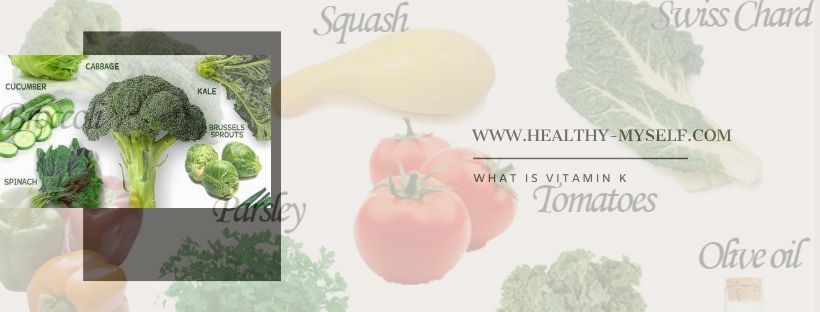
Vitamin K is actually a group of compounds.
The most important of these compounds are vitamin K1 and vitamin K2.
Vitamin K1 is found in leafy greens and some other vegetables.
Vitamin K2 is a group of compounds and largely found in meats, cheeses, and eggs, and synthesized by bacteria.
Low levels of vitamin K can increase the risk of uncontrolled bleeding.
While vitamin K deficiencies are rare in adults, they are very common infants.
A single injection dose of vitamin K for a newborns baby is standard.
You can take vitamin k supplement also-

Vitamin K Rich Food-

The following different foods are good sources of vitamin K.
Best 10 Vegetables High in Vitamin K Rich foods-

The best sources of vitamin K1 are found in leafy green vegetables.
In fact, the prefix “phyllo” refers to leaves.
Kale–
565 mcg per 1/2 cup, cooked
Vitamin K helps in blood clotting by enabling your body to make proteins involved in the blood clotting process.
Clotting is important because it helps prevent your body from bleeding too much.
Kale is the vitamin K king. It’s known as one of the Superfoods.
Rightfully so, because it’s also rich in Calcium, Potassium, and Folate.
Broccoli–
85 mcg per 1/2 cup, cooked
There are all sorts of ways to prepare Broccoli.
Whatever your recipe, try cooking it with canola oil or Olive Oil.
It is not only to add flavor but to boost the vitamin K content as well.
A tablespoon of either contains about 10 mcg of vitamin K is required.
Spinach–
444 mcg per 1/2 cup, cooked
Spinach is filled with all sorts of nutritional goodness, including vitamins A, B, and E, plus magnesium, folate, and iron.
A half-cup of cooked spinach contains about three times as much vitamin K as a cup of raw spinach does, but one raw serving is still plenty for one day.
Cabbage (cooked) — 68% DV per serving-
Half a cup: 82 mcg (68% DV)
100 grams: 109 mcg (91% DV)
Turnip greens–
425 mcg per 1/2 cup, cooked
Turnip greens are used in the Southeastern United States.
Turnip greens are also high in calcium, which helps strengthen bones.
Mustard greens and beet greens also contain high levels of vitamin K.
The bulbous part of the turnip that grows underground is nutritious, too.
Lettuce–
60 mcg per serving (1/2 head of iceberg or 1 cup of romaine)
However, Lettuce is probably the most popular and important source of vitamin K as per the American diet is a concern.
It’s available at salad bars and grocery stores across the country in different varieties.
Sauerkraut–
56 mcg per 1/2 cup
Pile your hot dog or sausage high with sauerkraut. You’ll get a nice punch of protein, too. Sauerkraut is readily available at many local eateries or chains.
Soybeans–
43 mcg per 1/2 cup, roasted
There are two main kinds of vitamin K, known as vitamin K-1 i.e. Phylloquinone, and K-2 i.e. Menaquinones.
K-1 comes from plants, while K-2 exists in smaller amounts in animal-based foods and fermented foods, such as cheese.
Soybeans and soybean oil contain more of the K-2 kind as well.
Pumpkin–
20 mcg per ½ cup canned
Save this one for the fall weather and Halloween.
Cabbage (cooked) — 68% DV per serving-
Half a cup: 82 mcg (68% DV)
100 grams: 109 mcg (91% DV)
Best 7 Fruits High in Vitamin k Rich Foods-
Fruits generally having less as much vitamin K1 as leafy green vegetables, but a few fruits provide decent amounts.
Avocado — 18% DV per serving-
Half, medium: 21 mcg (18% DV)
100 grams: 21 mcg (18% DV)
Tomatoes (sun-dried) — 4% DV per serving-
5 pieces: 4.3 mcg (4% DV)
100 grams: 43 mcg (36% DV)
Kiwi — 23% DV per serving-
1 fruit: 28 mcg (23% DV)
100 grams: 40 mcg (34% DV)
Blackberries — 12% DV per serving-
Half a cup: 14 mcg (12% DV)
100 grams: 20 mcg (17% DV)
Blueberries — 12% DV per serving-
Half a cup: 14 mcg (12% DV)
100 grams: 19 mcg (16% DV)
Pomegranate — 12% DV per serving-
Half a cup: 14 mcg (12% DV)
100 grams: 16 mcg (14% DV)
Grapes — 3% DV per serving-
10 grapes: 3.5 mcg (3% DV)
100 grams: 15 mcg (12% DV)
Best 7 Meat Products As High in vitamin k Rich Foods-
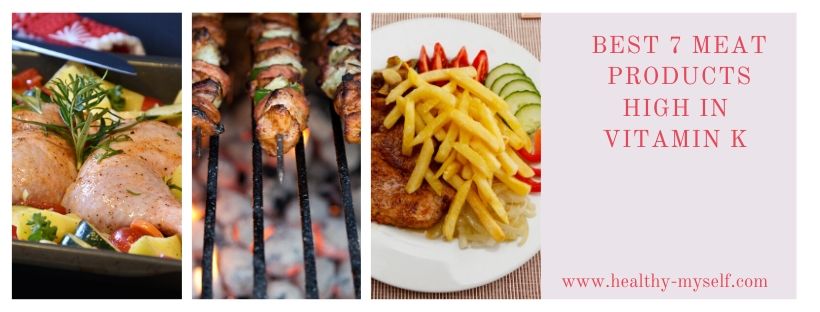
Fatty meats and liver are excellent sources of vitamin K2, though the content varies by the animal’s diet and may be different between regions or producers.
Below are 7 foods that provide very good or moderate amounts of vitamin K2.
Chicken — 43% DV per serving-
3 ounces: 51 mcg (43% DV)
100 grams: 60 mcg (50% DV)
Beef Liver — 60% DV per serving-
1 slice: 72 mcg (60% DV)
100 grams: 106 mcg (88% DV)
Pork Chops — 49% DV per serving-
3 ounces: 59 mcg (49% DV)
100 grams: 69 mcg (57% DV)
Ground Beef — 7% DV per serving-
3 ounces: 8 mcg (7% DV)
100 grams: 9.4 mcg (8% DV)
Duck Breast — 4% DV per serving-
3 ounces: 4.7 mcg (4% DV)
100 grams: 5.5 mcg (5% DV)
Beef Kidneys — 4% DV per serving-
3 ounces: 4.9 mcg (4% DV)
100 grams: 5.7 mcg (5% DV)
Chicken Liver — 3% DV per serving-
1 ounce: 3.6 mcg (3% DV)
100 grams: 13 mcg (11% DV)
Best 7 Dairy Foods As Vitamin K Rich Foods-
Dairy foods and eggs are also decent sources of vitamin K2.
Just like meat and, their vitamin content depends on the animal’s diet, and their values vary by region or producer.
Hard Cheeses — 20% DV per serving-
1 ounce: 25 mcg (20% DV)
100 grams: 87 mcg (72% DV)
Soft Cheeses — 14% DV per serving-
1 ounce: 17 mcg (14% DV)
100 grams: 59 mcg (49% DV)5. Blue Cheese — 9% DV per serving
1 ounce: 10 mcg (9% DV)
100 grams: 36 mcg (30% DV)
Egg Yolk — 5% DV per serving-
1 large: 5.8 mcg (5% DV)
100 grams: 34 mcg (29% DV)
Whole Milk — 3% DV per serving-
1 cup: 3.2 mcg (3% DV)
100 grams: 1.3 mcg (1% DV)
Butter — 2% DV per serving-
1 tablespoon: 3 mcg (2% DV)
100 grams: 21 mcg (18% DV)
Cream — 2% DV per serving-
2 tablespoons: 2.7 mcg (2% DV)
100 grams: 9 mcg (8% DV) Lassi-
It is also a dairy product and having a Vitamin K source.
Best 5 Nuts and Legumes High in Vitamin K-
Some legumes and nuts provide decent amounts of vitamin K1 but generally provide much less than leafy green vegetables.
Cashews — 8% DV per serving-
1 ounce: 9.7 mcg (8% DV)
100 grams: 34 mcg (28% DV)
Walnuts — 1% DV per serving-
1 ounce: 0.8 mcg (1% DV)
100 grams: 2.7 mcg (2% DV)
Sprouted Mung Beans (cooked) — 12% DV per serving-
Half a cup: 14 mcg (12% DV)
100 grams: 23 mcg (19% DV)
Hazelnuts — 3% DV per serving-
1 ounce 4 mcg (3% DV)
100 grams: 14 mcg (12% DV)
Pine Nuts — 1% DV per serving-
10 nuts: 0.9 mcg (1% DV)
100 grams: 54 mcg (45% DV)
Vitamin K deficiency symptoms–
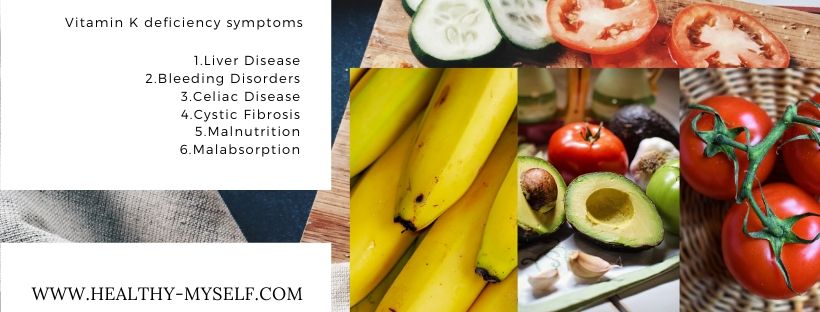
Following diseases may occur due to Vitamin K deficiency-
- Liver Disease
- Bleeding Disorders
- Celiac Disease
- Cystic Fibrosis
- Malnutrition
- Malabsorption
- Inflammatory Bowel Disease
The main symptom of vitamin deficiency–
Excessive bleeding and not clotting properly.
The bleeding may also be apparent if someone:
- bruises easily
- gets small blood clots underneath their nails
- bleeds in mucous membranes that line areas inside the body
In the case of infants, Doctors may observe this vitamin deficiency if there is:
- bleeding from the area where the umbilical cord is removed
- bleeding in the skin, nose, gastrointestinal tract, or other areas
- bleeding at the point of the penis if the baby has been circumcised
- sometimes sudden bleeding in the brain, which is extremely dangerous often and life-threatening
Vitamin K deficiency causes–
Although the deficiency is rare in adults certain people are at increased risk if they:
- take coumarin anticoagulants such as warfarin, which thins the blood
- are taking antibiotics
- have a diet and is extremely lacking in this vitamin
Coumarin anticoagulants interfere with the production of the proteins involved in blood clotting.
Surprisingly some of the antibiotics cause the body to produce less of its own vitamin K.
You can take Vitamin K Food Supplements also-

Newborn babies are at increased risk for the deficiency for so many reasons:
- breast milk is very low in this vitamin.
- as per research, this vitamin does not transfer very well from a mother’s placenta to her baby
- newborns can not produce vitamin K2 on their own in the first few days of life span
Vitamin K Chemical Name-
2-methyl-3-[(2E)-3,7,11,15-tetramethylhexadec-2-en-1-yl]naphthoquinone
Phylloquinone, Menaquinone
It also is known as phylloquinone, is made by plants, and is found in the highest amounts in green leafy vegetables because it is directly involved in photosynthesis.
Phytonadione is a man-made form of vitamin K that that occurs naturally in the body.
Vitamin K Uses-
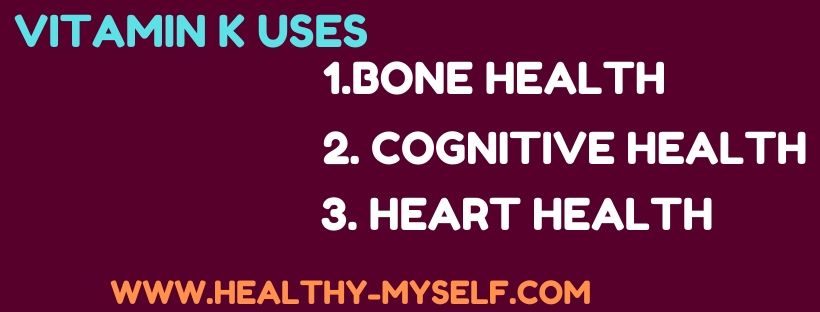
This Vitamin benefits the body in various ways.
Bone health–
Several kinds of research found that it supports the maintenance of strong bones and improves bone density.
It decreases the risk of Fractures.
However, research has not confirmed this.
Cognitive health–
It increased blood levels of this vitamin.
It improved episodic memory in older adults.
In one study, healthy individuals over the age of 70 years with the highest blood levels of vitamin K1 had the highest verbal episodic memory performance.
Heart health–
This Vitamin may help keep your BP levels lower by preventing mineralization, where minerals build up in the arteries.
This enables the heart to pump blood circulation freely through the body.
Conclusion-
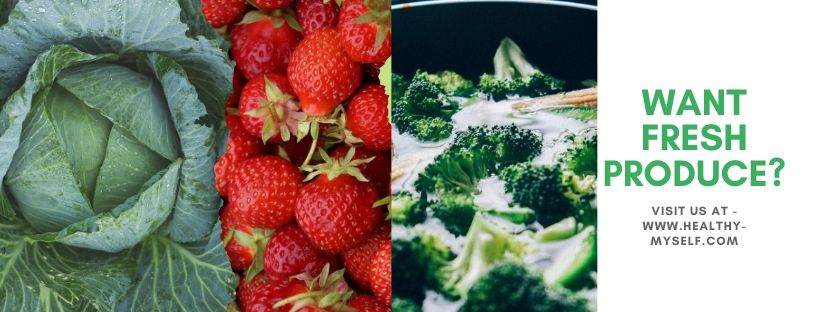
It is a fat-soluble vitamin.
You need it every day for good health.
It helps your blood to clot when you are bleeding.
People who take warfarin should aim for about the same amount of this vitamin each day.
Warfarin is a blood-thinning medication.
It also helps to build strong bones.
There are two types of vitamin K:
vitamin K1 & vitamin K2.
- Vitamin K1 is mostly found in plants i.e. green vegetables and is our main dietary source.
- Vitamin K2 is obtained in fermented foods and found in some meats & cheeses.
You can read here also- https://en.wikipedia.org/wiki/Vitamin_K
- I’d like to grow my readership.
- Can you help me out by sharing this blog post with family, friends & colleagues?
- What other ideas can you add to this list that I may have not mentioned please write to us?
